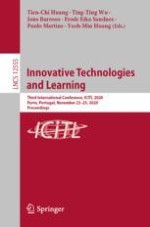2020 | OriginalPaper | Buchkapitel
How Engineering Design Ability Improve via Project-Based Truss Tower STEM Course?
verfasst von : Wan-Hsuan Yen, Chi-Cheng Chang
Erschienen in: Innovative Technologies and Learning
Aktivieren Sie unsere intelligente Suche, um passende Fachinhalte oder Patente zu finden.
Wählen Sie Textabschnitte aus um mit Künstlicher Intelligenz passenden Patente zu finden. powered by
Markieren Sie Textabschnitte, um KI-gestützt weitere passende Inhalte zu finden. powered by
